The MSI Z170A SLI PLUS Review: Redefining the Base Line at $130
by Ian Cutress on April 13, 2016 8:00 AM EST- Posted in
- Motherboards
- MSI
- Skylake
- Z170
System Performance
Not all motherboards are created equal. On the face of it, they should all perform the same and differ only in the functionality they provide - however this is not the case. The obvious pointers are power consumption, but also the ability for the manufacturer to optimize USB speed, audio quality (based on audio codec), POST time and latency. This can come down to manufacturing process and prowess, so these are tested.
Power Consumption
Power consumption was tested on the system while in a single MSI GTX 770 Lightning GPU configuration with a wall meter connected to the OCZ 1250W power supply. This power supply is Gold rated, and as I am in the UK on a 230-240 V supply, leads to ~75% efficiency > 50W, and 90%+ efficiency at 250W, suitable for both idle and multi-GPU loading. This method of power reading allows us to compare the power management of the UEFI and the board to supply components with power under load, and includes typical PSU losses due to efficiency. These are the real world values that consumers may expect from a typical system (minus the monitor) using this motherboard.
While this method for power measurement may not be ideal, and you feel these numbers are not representative due to the high wattage power supply being used (we use the same PSU to remain consistent over a series of reviews, and the fact that some boards on our test bed get tested with three or four high powered GPUs), the important point to take away is the relationship between the numbers. These boards are all under the same conditions, and thus the differences between them should be easy to spot.
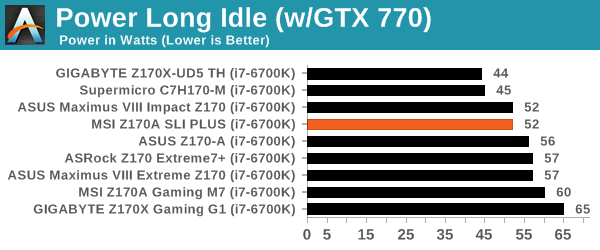
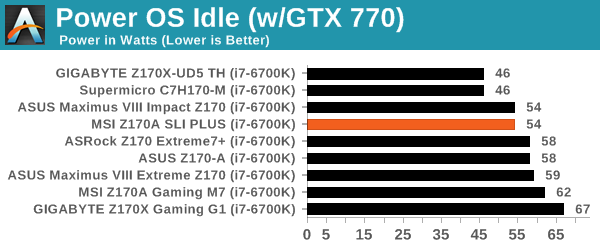
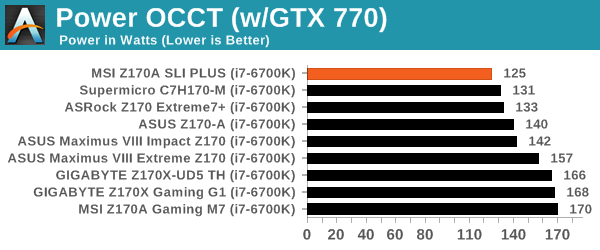
As a low cost motherboard, there are two ways a power reading can be interpreted. If it’s low, then due to the lack of controllers compared to the high end motherboards, this is to be expected. If high, then the power delivery might be a budget implementation with reduced efficiency. For the MSI Z170A SLI PLUS, we got an impressive 73W delta from long idle to load in our test, with the load power being the lowest we’ve seen on a Z170 motherboard so far.
Non UEFI POST Time
Different motherboards have different POST sequences before an operating system is initialized. A lot of this is dependent on the board itself, and POST boot time is determined by the controllers on board (and the sequence of how those extras are organized). As part of our testing, we look at the POST Boot Time using a stopwatch. This is the time from pressing the ON button on the computer to when Windows 7 starts loading. (We discount Windows loading as it is highly variable given Windows specific features.)
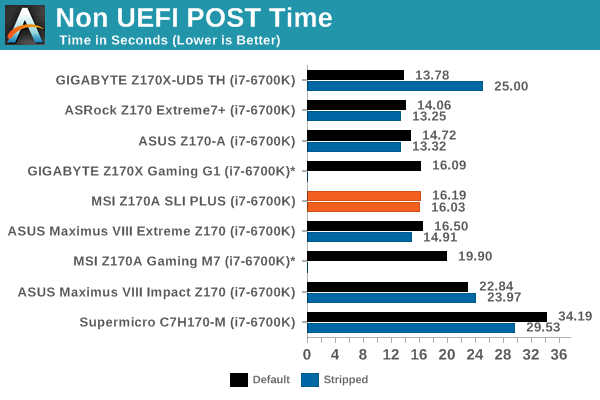
For whatever reason, when Z170 was launched there was a regression in POST times from most motherboard manufacturers. DDR4 training does take longer than DDR3 used to, but instead of sub 10-seconds being a good target, for Z170 anything under 15-seconds is good to see. The SLI PLUS floats on the 16 second boundary here, with not much change when the BIOS is stripped and controllers disabled.
Rightmark Audio Analyzer 6.2.5
Rightmark:AA indicates how well the sound system is built and isolated from electrical interference (either internally or externally). For this test we connect the Line Out to the Line In using a short six inch 3.5mm to 3.5mm high-quality jack, turn the OS speaker volume to 100%, and run the Rightmark default test suite at 192 kHz, 24-bit. The OS is tuned to 192 kHz/24-bit input and output, and the Line-In volume is adjusted until we have the best RMAA value in the mini-pretest. We look specifically at the Dynamic Range of the audio codec used on board, as well as the Total Harmonic Distortion + Noise.

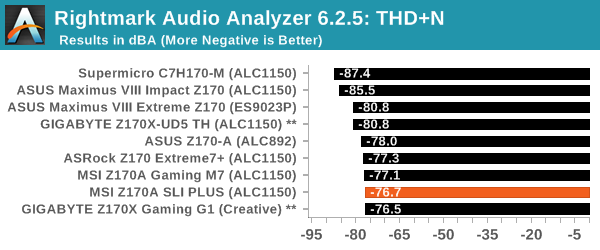
We noted earlier in the review that for a low-cost motherboard, MSI still implemented the Realtek ALC1150 codec with a few modifications like PCB separation and filter caps, but not the big modifications we see on more expensive products. The ALC1150 still performs reasonablt well on SNR, although THD+N isn’t the best we’ve seen.
USB Backup
For this benchmark, we transfer a set size of files from the SSD to the USB drive using DiskBench, which monitors the time taken to transfer. The files transferred are a 1.52 GB set of 2867 files across 320 folders – 95% of these files are small typical website files, and the rest (90% of the size) are small 30 second HD videos. In an update to pre-Z87 testing, we also run MaxCPU to load up one of the threads during the test which improves general performance up to 15% by causing all the internal pathways to run at full speed.
Due to the introduction of USB 3.1, as of June 2015 we are adjusting our test to use a dual mSATA USB 3.1 Type-C device which should be capable of saturating both USB 3.0 and USB 3.1 connections. We still use the same data set as before, but now use the new device. Results are shown as seconds taken to complete the data transfer.
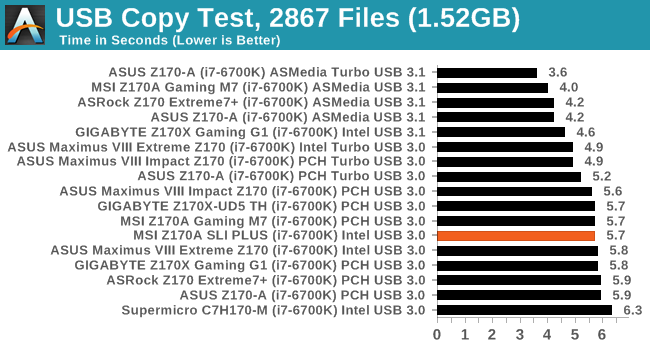
Unfortunately, due to the USB Type-C on the motherboard and my lack of a cable that isn’t cat-chewed, we were only able to run USB 3.0 results in time for the review. This came in at 5.7 seconds, a nice medium between the two collections at 5.6 and 5.8.
DPC Latency
Deferred Procedure Call latency is a way in which Windows handles interrupt servicing. In order to wait for a processor to acknowledge the request, the system will queue all interrupt requests by priority. Critical interrupts will be handled as soon as possible, whereas lesser priority requests such as audio will be further down the line. If the audio device requires data, it will have to wait until the request is processed before the buffer is filled.
If the device drivers of higher priority components in a system are poorly implemented, this can cause delays in request scheduling and process time. This can lead to an empty audio buffer and characteristic audible pauses, pops and clicks. The DPC latency checker measures how much time is taken processing DPCs from driver invocation. The lower the value will result in better audio transfer at smaller buffer sizes. Results are measured in microseconds.

Similarly to POST times, DPC Latency seems to either be quite good or rather bad on the current crop of Z170 motherboards. The SLI PLUS is better than most, hovering just above 110 microseconds at its peak.










62 Comments
View All Comments
Dr. Swag - Wednesday, April 13, 2016 - link
Hey Ian, any word on how far along the x4 845 review your promised a while back is? I'm very interested in it but it's been quite a while now. I know you've been busy on other reviews but just want to know how that's going. If you don't know what I'm talking about:http://www.anandtech.com/comments/10000/who-contro...
Ian Cutress - Wednesday, April 13, 2016 - link
It's taken a couple of weeks, but I think the X4 845 is tested (regular and OC). Just need to run through a couple of older gen chips to see difference / IPC - X4 760K only arrived yesterday. Should have the 860K in there as well, all three tested at stock and 3G for comparison - CPU (office, synthetic and realworld tests) and gaming performance are both covered. I've also got a set of i3 parts on the go, most of the new E3 Xeons, an FX retest and new A10 reviews in flight, so apologies for the delays. If you've been following my twitter feed recently, I've been updating the test work flow to hopefully optimize this for the future... :)Dr. Swag - Wednesday, April 13, 2016 - link
Awesome man! Just take your time and don't rush it :). Thanks for the reply/update.owan - Wednesday, April 13, 2016 - link
I wish more mid-high end boards would sport color schemes like this. If you want to do a mod project, this is like a blank slate that can work with nearly any theme. Unfortunately high end boards usually have one gaudy color that you can't ignore or alter without significant work. I get that its all part of the branding, but having such a neutral color scheme would have been nice when doing my own project.... I found myself having to use red in my build just to make my Asus ROG board (purchased prior to the project) work, even though I don't really care for the color.ImSpartacus - Wednesday, April 13, 2016 - link
I know! Why is a tasteful black & gray so troubling to get right?Questor - Wednesday, April 13, 2016 - link
Amen to that! I saw the MSI X99A Godlike Gaming Carbon and dropped three credit cards on the floor trying to get the one I initially grabbed! At that point, I had not idea what socket, what the specs were and what was generally compatible. I saw the awesome black and shiny combo, like a black muscle car with lots of chrome and went lights out. I came too when my walked up to me and asked why I had my cards out and why is that big black and metal thing $600.00?!!!Impulses - Thursday, April 14, 2016 - link
Agreed, this was a factor in me picking the ASUS Z170-A, seemed like every other board in the same price range (before this MSI, which didn't come out until the end of last year) was pimping a red scheme or something bolder.Oxford Guy - Wednesday, April 13, 2016 - link
Give us a Skylake that makes use of its EDRAM controller (by having EDRAM) and then I'll care about this generation of boards.Oxford Guy - Wednesday, April 13, 2016 - link
Probably in the same file with the GTX 960. "Coming real soon."KLC - Wednesday, April 13, 2016 - link
So I'm in the early stages of thinking about a new build. I don't do this often, I'm currently using aQ6600 box I built almost 8 years ago. I don't game, I don't overclock, I'll use the integrated graphics with an SSD and HDD for storage. Most uses are standard office apps, web browsing plus media, and photography using Adobe Lightroom and Photoshop with a little video using Sony Vegas. There is a bewildering array of motherboards out there. I want a quality mb with quality components, good sound and the latest USB ports but since I'm not on the extreme bleeding edge I don't need to spend a fortune for a mb. This one looks like it might be a good fit for me. Am I right or are there other mbs out there I should look at?